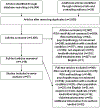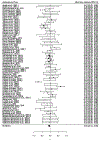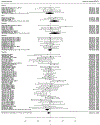Respiratory sinus arrhythmia reactivity across empirically based structural dimensions of psychopathology: A meta-analysis
- PMID: 30672603
- PMCID: PMC6453712
- DOI: 10.1111/psyp.13329
Respiratory sinus arrhythmia reactivity across empirically based structural dimensions of psychopathology: A meta-analysis
Abstract
Low resting respiratory sinus arrhythmia (RSA) is observed in many mental health conditions, including anxiety disorders, mood disorders, schizophrenia spectrum disorders, disruptive behavior disorders, and nonsuicidal self-injury, among others. Findings for RSA reactivity are more mixed. We evaluate associations between RSA reactivity and empirically derived structural categories of psychopathology-including internalizing, externalizing, and thought problems-among physically healthy adults. We searched multiple electronic databases for studies of RSA among participants who were assessed either dimensionally using well-validated measures or diagnostically using structured interviews. Strict inclusion criteria were used to screen 3,605 published reports, which yielded 37 studies including 2,347 participants and 76 effect sizes. We performed a meta-analysis, with meta-analytic regressions of potential moderators, including psychopathology subtypes. The sample-wide meta-analytic association between RSA reactivity and psychopathology was quite small, but heterogeneity was considerable. Moderation analyses revealed significant RSA reactivity (withdrawal) specifically in externalizing samples. Additional moderators included (a) stimulus conditions used to elicit RSA reactivity (only negative emotion inductions were effective), (b) sex (women showed greater RSA reactivity than men), and (c) adherence to established methodological guidelines (e.g., higher electrocardiographic sampling rates yielded greater RSA reactivity). These findings indicate that associations between RSA reactivity and psychopathology are complex and suggest that future studies should include more standardized RSA assessments to increase external validity and decrease measurement error.
Keywords: HRV; RSA; meta-analysis; psychopathology; reactivity.
© 2019 Society for Psychophysiological Research.
Figures






References
-
- American Psychiatric Association. (1987). Diagnostic and statistical manual of mental disorders (3rd ed., revised). Washington, DC: Author.
-
- American Psychiatric Association. (1994). Diagnostic and statistical manual of mental disorders (4th ed.). Washington, DC: Author.
-
- American Psychiatric Association. (2013). Diagnostic and statistical manual of mental disorders (5th ed.). Arlington, VA; Author.
Publication types
MeSH terms
Grants and funding
LinkOut - more resources
Full Text Sources
Medical

